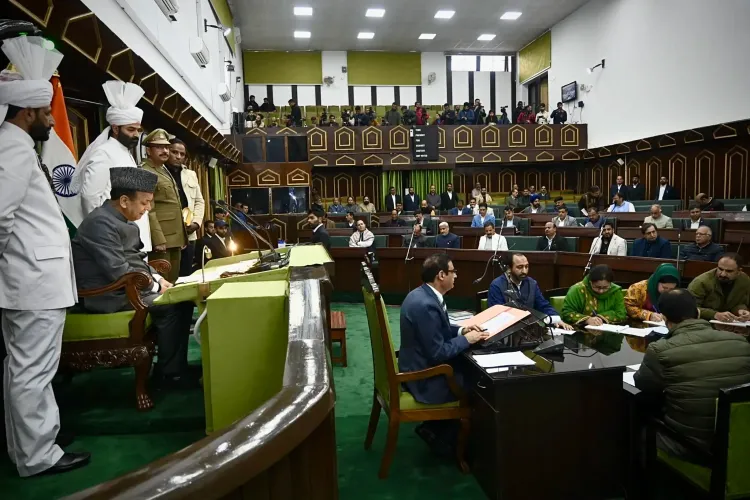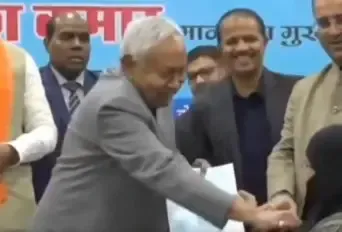Road Connectivity and Jal Shakti Issues Discussed in J&K Assembly

Synopsis
Key Takeaways
- Construction of a tunnel for Keran-Jumgund connectivity.
- 2,548.75 hectares of saffron land rejuvenated.
- 85 bore wells handed over for irrigation, facing challenges.
- Saffron prices increased significantly due to new technologies.
- Rs 132 crore allocated for drinking water supply in Bandipora.
Jammu, March 4 (NationPress) In response to a query from MLA Mir Saifullah during the question hour in the J&K Assembly on Tuesday, Deputy Chief Minister Surinder Choudhary announced that the construction of a tunnel on the route connecting the Keran and Jumgund areas of Kupwara district to ensure all-weather connectivity will be brought to the attention of the Union Ministry of Road Transport and Highways.
Choudhary mentioned that the DPR for this project would be prepared and submitted to the central government.
“The Keran sector of Kupwara is linked to the rest of J&K through the Pharkiyan Gali to Keran road (46.76 Km), which is maintained by the Border Roads Organisation (BRO).
“This road is partially closed during winter due to snow buildup, and the BRO conducts regular snow clearance to maintain access to the Keran sector. The PMGSY Road Zirhama-Jumgund (25.00 km) is a high-altitude road. Although snow clearance operations are routinely carried out, heavy snowfall can complicate efforts beyond the first six kilometers, leading to delays until conditions improve due to visibility issues, frost, and avalanches/snowslides from higher elevations, particularly between kilometers 17 and 20. Currently, there are no alternative routes for the Keran and Jumgund regions,” he explained.
In response to another inquiry from MLA Justice (Retd) Hasnain Masoodi, Minister for Agricultural Production Javed Ahmad Dar revealed that a total of 2,548.75 hectares of saffron land has been revitalized under the National Mission on Saffron.
He stated that the mission has made substantial progress, particularly in enhancing irrigation systems and rejuvenating saffron lands.
The minister indicated that the decline in saffron cultivation has been effectively halted, with the area under saffron remaining stable at 3,715 hectares (3,665 Ha in the Kashmir division and 50 Ha in Kishtwar) since 2010-11, with additional areas identified for expansion supported by the HADP.
He noted that productivity has risen from 2.50 kg/ha in 2009-10 to a peak of 4.42 kg/ha in the rejuvenated areas during 2023.
Furthermore, he mentioned that the National Saffron Mission has initiated plans to construct a network of 124 community bore wells, each designed to serve an area of 30 hectares, linked to sprinkler irrigation systems to cater to a total of 3,665 hectares of saffron fields.
“So far, 85 bore wells have been handed over to the Agriculture Department, but efforts to build the remaining 39 bore wells have encountered significant challenges. Despite numerous tender invitations, there has been a consistent lack of participation in the tendering process. This has resulted in considerable delays in developing the necessary irrigation infrastructure. A committee established by the government has determined that 77 bore wells have been non-operational for an extended period. A Rs 400 Crore project was sanctioned in 2010-11 by the Union Ministry of Agriculture and Cooperation to enhance saffron production and economic revival,” he added.
He continued that the establishment of Saffron Park/IIKSTC has enabled farmers to achieve better prices, soaring from Rs. 80,000 per kg to Rs. 2,20,000 per kg during 2021-22. The implementation of various scientific post-harvest processing techniques has improved saffron stigma recovery from 22g/kg to 28g/kg (an increase of 6g/kg) during 2021-22.
“The mission has introduced new technologies through the Indian Institute of Kashmir Saffron and Technology Center (IIKSTC), leading to an enhancement in saffron color quality from 8 percent (traditional drying) to 16 percent (scientific drying). The mission has addressed the issue of intermediaries taking advantage of saffron producers by implementing e-auctions at IIKSTC, which has ensured fair farm-gate prices and facilitated transparent transactions throughout India, significantly reducing the power of intermediaries. The Agriculture Department has made dedicated efforts to counteract the disruptive actions of unwelcome elements among saffron farmers, which included damage to sprinkler irrigation systems and bore wells. The presence of real estate players and land grabbers poses a major threat to the successful cultivation of saffron in the region, prompting complaints to the relevant revenue authorities,” he stated.
“While monitoring and evaluating the initiatives undertaken under the Saffron Mission, it is evident that most of the objectives and outcomes have been successfully achieved, although a few objectives remain incomplete due to various challenges. The Department has continuously engaged local leaders and saffron growers in policymaking to benefit farmers. Committees composed of saffron farmers, traders, civil society members, and other stakeholders have been established to ensure their perspectives are taken into account,” the minister concluded.
In response to a question posed by Nizamuddin Bhat, MLA, Jal Shakti Minister Javed Ahmad Rana informed the assembly that an amount of Rs 132 crore has been allocated for enhancing drinking water supply schemes under JJM/ UT Capex/ AMRUT 2.0 in the Bandipora constituency.
The Minister also mentioned that the DPR for the water supply scheme for the Bandipora Town project to be executed under AMRUT 2.0 is currently being surveyed and developed.
“Providing potable drinking water to every household is a national priority initiated by the Prime Minister in 2019 under the Jal Jeevan Mission for rural areas, and it has also been launched under AMRUT-2.0 for urban areas in Jammu & Kashmir,” the minister stated.










